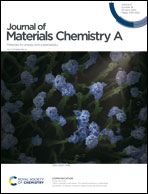Photoactivated transition metal dichalcogenides to boost electron extraction for all-inorganic tri-brominated planar perovskite solar cells†
Abstract
The band-energy structure, electron mobility and electronic trap states of the electron-transporting layer (ETL) are critical for perovskite solar cells (PSCs). However, the state-of-the-art titanium oxide (TiO2) ETL prepared by means of high-temperature processing technology requires a long preparation time and a lot of energy consumption; and the low-temperature processed species always present unfavourable electrical properties. In this work, we demonstrate that photoactivated transition metal dichalcogenide quantum dots (TMDC QDs, MoS2 and MoSe2) boosted a low-temperature processed TiO2 (L-TiO2) ETL for all-inorganic CsPbBr3 PSCs without a hole-transporting layer or precious metal electrode. Arising from the photogenerated electron injection from TMDC QDs to L-TiO2 under light irradiation, the electronic trap states and the electron mobility of ETL were effectively regulated, which in turn significantly enhanced the electron extraction from perovskite to the L-TiO2 ETL and reduced the carrier recombination. Finally, the optimal CsPbBr3 PSC achieves an enhanced power conversion efficiency of 10.02% with an ultrahigh open-circuit voltage of 1.615 V and excellent long-term stability, providing a new path to efficient photovoltaic devices.



 Please wait while we load your content...
Please wait while we load your content...